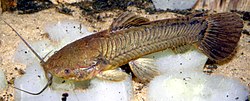
Callichthyidae is a family of catfishes, called armored catfishes due to the two rows of bony plates along the lengths of their bodies. It contains some of the most popular freshwater aquarium fish, such as many species in the genus Corydoras.

Loricariidae is the largest family of catfish, with 92 genera and just over 680 species. Loricariids originate from freshwater habitats of Costa Rica, Panama, and tropical and subtropical South America. These fish are noted for the bony plates covering their bodies and their suckermouths. Several genera are sold as "plecos", notably the suckermouth catfish, Hypostomus plecostomus, and are popular as aquarium fish.

Otocinclus is a genus of catfish in the family Loricariidae native to South America, commonly known as "dwarf suckers" or "otos". This genus, like other loricariids, is characterized by rows of armour plating covering the body, as well as the underslung suckermouth. They are generally small in size; O. tapirape is the smallest of the species (2.4 cm), while O. flexilis is the biggest (5.5 cm). These species have adaptations that allow them to breathe air. A duct forms at the junction between the esophagus and the stomach and expands into an enlarged, ring-like diverticulum, characteristic of this genus, which allows air-breathing. Otocinclus are popular aquarium fish, and they are often purchased as algae eaters. It is difficult to breed them in captivity, and only wild caught Otocinclus are available to hobbyists. This genus is widely distributed east of the Andes of South America, throughout the lowlands from northern Venezuela to northern Argentina, but are generally absent from the Amazon and the Orinoco lowlands.

Aspidoras is a genus of catfishes of the family Callichthyidae from Brazil.

Callichthys callichthys, the cascarudo, armored catfish, bubblenest catfish, hassar, or mailed catfish, is a subtropical freshwater fish belonging to the subfamily Callichthyinae of the family Callichthyidae.

Baryancistrus is a genus of freshwater Loricariid catfish. They inhabit flowing sections of rivers, especially clearwater, in the basins of the Amazon and Orinoco in Brazil and Venezuela. The largest species reach up to 34 cm (13 in) in total length.
Lepthoplosternum is a small genus of freshwater catfish in the Callichthyinae subfamily of the armored catfish family.

Megalechis is a small genus of freshwater catfish in the Callichthyinae subfamily of the armored catfish family.
Callichthys fabricioi is a tropical freshwater fish belonging to the Callichthyinae sub-family of the family Callichthyidae. The fish will grow in length up to 12.5 centimetres (5 in) SL. C. fabricioi is found in the trans-Andean upper Cauca River in the Magdalena River basin of Colombia. Although described in 1999, two other cogener fish have since been discovered.
Callichthys serralabium is a tropical freshwater fish belonging to the Callichthyinae sub-family of the family Callichthyidae.

Parotocinclus is a genus of fish in the family Loricariidae native to South America. This genus is distributed through almost all hydrographic systems in South America from the Guyana Shield drainages and Amazon Shield tributaries to the coastal drainages of eastern and southeastern Brazil, including the rio São Francisco basin. Most species have the caudal peduncle oval in cross section. It has been found that Characidium species may interact with P. maculicauda. The small Characidium will follow grazing P. maculicauda, which release particulate matter dislodged from the catfish's foraging.
Entomocorus melaphareus is a species of driftwood catfish endemic to Brazil where it is found in the Amazon River. It grows to a length of 5.9 cm and can be distinguished from its congeners by an inconspicuous patch exists on the dorsal lobe of the caudal fin. It also has pigmented pectoral and pelvic fins, while these fins in the other three species are unpigmented.

Entomocorus radiosus is a species of driftwood catfish endemic to Brazil where it is found in the Rio Paraguay in the Pantanal region of Mato Grosso. It is the smallest known member of its genus growing to a length of 5.3 cm. It can be distinguished from its congeners because its anal fin base is longer and has more branched anal fin rays. E. radiosus is a zooplanktivore which also eats insects; this species predominantly consumes microcrustaceans, but also fed on insects.
Lepthoplosternum altamazonicum is a species of catfish of the family Callichthyidae. It is found in the upper Amazon River basin in Peru and Brazil,
Lepthoplosternum beni is a species of catfish of the family Callichthyidae. It is found in the upper Madeira River basin in Bolivia and Peru.
Lepthoplosternum pectorale is a species of catfish of the family Callichthyidae. It is found in Argentina, Brazil and Paraguay where it occurs in the Paraguay River.
Lepthoplosternum stellatum is a species of catfish of the family Callichthyidae. This species is so far known from the type locality only, the Igarapé Repartimento, a tributary of the mouthbay lake, Tefé Lake, some 6 km south of the town of Tefé, Amazonas, Brazil.
Lepthoplosternum tordilho is a species of catfish of the family Callichthyidae that is found in the lower Jacui River drainage in southern Brazil.
Lepthoplosternum ucamara is a species of catfish of the family Callichthyidae. This species is known from the Pacaya-Samiria National Reserve in the lower Ucayali River in Peru and from the area of confluence of the Solimões River and Japurá River in Brazil.

Megalechis picta, the Tail bar armored catfish, Tail bar hoplo or Spotted Hoplo, is a species of catfish of the family Callichthyidae. M. picta occurs east of the Andes in the Amazon, Orinoco, and upper Essequibo River basins, and coastal rivers of northern Brazil.










